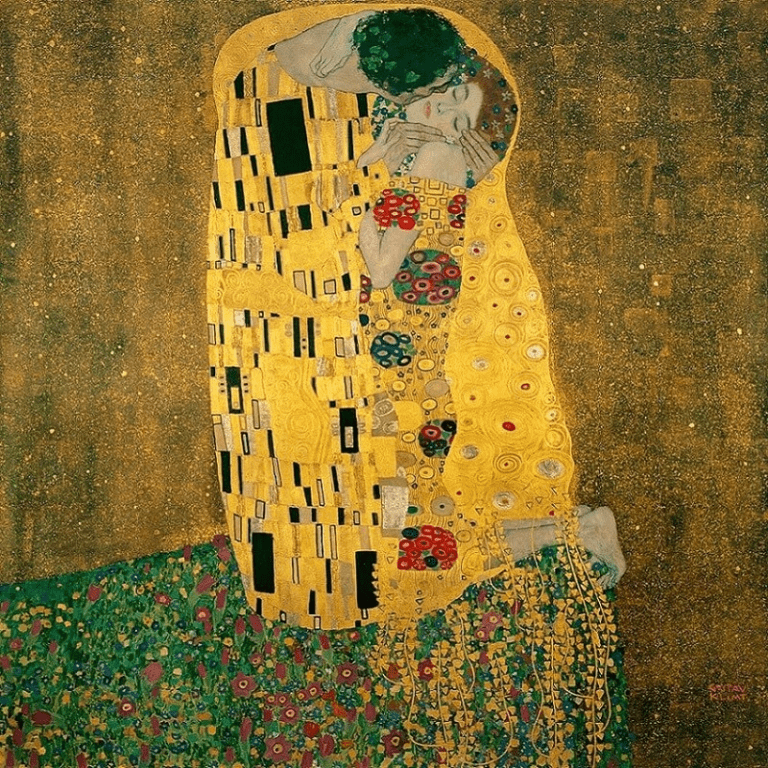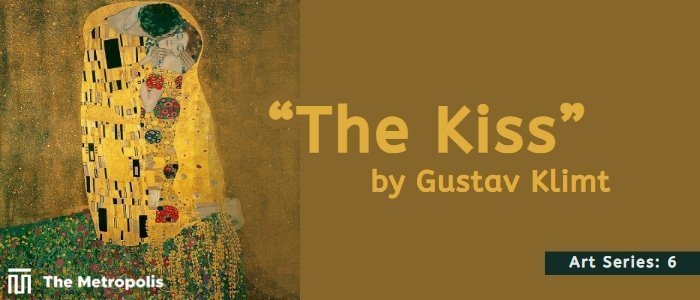Arya Tabassum –
“The Kiss” (in German “Der Kuss”) is a painting, drawn between 1907 and 1908, by Austrian Symbolist artist Gustav Klimt. This is widely recognized as a masterpiece of the Art Nouveau movement and has evolved into one of the most recognizable paintings in Western art history. The painting is currently on display at the Austrian Gallery Belvedere in Vienna, Austria. Its impressive size of 6 feet by 6 feet echoes off the wall as the life-size, gold-wrapped figures embrace.

The painting was created during a period of great social and cultural change in Europe. Klimt was a leading player in the Art Nouveau movement, which was distinguished by its embrace of novel shapes, materials, and techniques above established artistic traditions. The emphasis on sensuality and erotica was another characteristic of the movement, and Klimt’s “The Kiss” is no exception.
A couple in a passionate embrace is the focal point of the painting. The woman is wearing an ornate outfit covered in gold leaf, while the guy is represented in a plain robe. Klimt’s distinctive element of style, the gold leaf, is employed liberally throughout the work and is frequently understood as a symbol of spiritual and creative vitality.
The painting is noteworthy for utilizing a style known as “ornamental abstraction”, which was a defining feature of the Art Nouveau movement. To give the composition a sense of fluidity and movement, this approach uses decorative motifs and patterns that are frequently inspired by nature. This strategy is well applied in “The Kiss”, where the couple’s attire and the whirling background both have elaborate patterns and designs that catch the eye and give the picture depth.
The use of gold leaf is one of the painting’s most noticeable features. In “The Kiss”, Klimt used this material to convey a sense of wealth and luxury. Klimt was recognized for using this material in several of his works. The woman’s gown and the man’s robe are covered in tiny squares and rectangles of gold leaf that have been put in a mosaic-like design. This imparts a shimmering, almost magical look to the painting that is both lovely and motivating.
The significance of “The Kiss” has been the subject of much speculation among art historians. Others have viewed it as a celebration of the sensuous aspects of human relationships, while some have said that it is a representation of the ideal of romantic love. Being notoriously secretive about his personal affairs, Klimt himself never divulged the exact significance of the picture.
Regardless of the couple’s exact identities, it is well-known that the picture is a celebration of the power of love and sensuality. With intricate patterns and shapes woven into the fabric of the pair’s clothing and the background of the painting, the embrace of the couple is portrayed in a highly stylized and decorative way. The result emphasizes the idea that love can transcend the limitations of individual identity and connect us to something higher than ourselves by fostering a sense of togetherness and harmony between the figures and their environment.
However, there is also a sense of melancholy and desire present in the artwork. Since the woman’s face is obscured, there may be some doubt or ambiguity regarding the figures’ relationship with one another. A thicket of flowers and other plants surrounds the couple, maybe representing the difficulties that can occur in romantic relationships.
The way Klimt caught the private moment between the pair in “The Kiss” is one of its most remarkable features. The woman’s closed eyes and slightly parted lips are depicted on her face in great detail. A variety of swirling patterns are displayed in her hair, which seems to blend in perfectly with the golden robes that both characters are wearing.
As she embraces her partner, the woman’s face is slightly turned away from the observer and her eyes are closed with joy. Her skin is depicted in a lovely, creamy color with fine brushstrokes that allude to the warmth and delicacy of real flesh. Her hair falls down her back in a tangle of gold and copper, a riot of curls and waves.
On the other hand, the woman’s head partially hides the man’s face, yet his eyes look straight at the viewer with a mix of love and desire. This has given rise to a lot of conjecture on his identity and what he might symbolize in the painting. He may be Klimt himself, according to some art historians, but others contend that he is meant to be a universal symbol of masculinity.
The couple’s embrace is both tender and erotic, with the woman’s arms wrapped around the man’s neck and her leg lifted slightly off the ground. The man draws her in with his arms around her waist in a display of both passion and protection. The couple’s bodies mirror the sinuous curves and flowing lines of ancient Greek and Roman sculpture in this classical sculpture-like stance.
Blue, green, and gold swirls create a sense of movement and energy in the painting’s background, which is a riot of color and pattern. The patterns include organic shapes and curves that evoke the natural world and are reminiscent of Art Nouveau elements. The picture has an aura of unearthly beauty and elegance due to the ornamental abstraction and the glittering gold leaf.
Another noteworthy aspect of “The Kiss” is the way Klimt combined pattern and color to convey depth and motion. Both figures’ robes are decorated with a variety of elaborate geometric patterns that appear to radiate outward from the painting’s center. The addition of gold leaf enhances the piece’s wealth and luxury while highlighting the sensual aspect of the subject matter.
Due to its sensual subject matter and the fact that the pair are not married, “The Kiss” was widely regarded at the time of its production as being rather scandalous. Some art reviewers first condemned the artwork for being overly ornamental and superficial. However, it rapidly became well-liked by the general public and has since turned into one of Klimt’s most well-known pieces.
In addition to its artistic value, “The Kiss” also has a fascinating history. Klimt was asked to paint a portrait of Adele, the wife of a wealthy industrialist named Ferdinand Bloch-Bauer. Adele and Klimt were good friends, and some people have conjectured that they were romantically linked. However, this notion is not backed up by any hard evidence.
The painting remained for many years in the Bloch-Bauer family. This painting, along with many other pieces of art, was taken by the Nazis during World War II. The Bloch-Bauer family received the painting back after the war, although it was ultimately sold to a private American collector.
In 2006, the painting was sold at auction to the Neue Galerie in New York City for a record-breaking 135 million US dollars, making it one of the most expensive paintings ever sold.
“The Kiss” can be interpreted in numerous ways as a celebration of love and closeness. Over the years, the artwork has been interpreted in a wide variety of ways, with some perceiving it as a representation of spiritual oneness and others as a sign of sexual liberty. Because of its legendary prominence, it has come to represent love and romance for countless generations of people all over the world. “The Kiss” has been reproduced countless times, and it has been the subject of numerous homages in popular culture.
From poems to novels, “The Kiss” has served as an inspiration for numerous works of fiction. In one of the most well-known versions, F. Scott Fitzgerald’s “The Great Gatsby” describes the picture as a representation of the hedonistic and romantic lifestyle of the Roaring Twenties. Humbert Humbert, the main character in Vladimir Nabokov’s novel “Lolita”, refers to the artwork as a “perverse classic”. The painting has also been mentioned in writings by Toni Morrison, Sylvia Plath, and many others.
Over the years, “The Kiss” has also made appearances on the big screens. In the 1998 film “Ever After”, Drew Barrymore’s character can be seen gazing in awe at the painting while touring a gallery. The painting appears in a sequence in the 2001 movie “Moulin Rouge!”, where Nicole Kidman’s character, Satine, posed as a model for the painting. Along with these movies, “The Kiss” has also been seen in “Gattaca”, “The Reader”, and “The Girl with the Dragon Tattoo”.
Even in the world of music, “The Kiss” has made an appearance in songs by many musicians, such as “Kiss” by The Prince, “The Kiss” by The Cure, “The Lovers’ Waltz” by Jay Ungar, and “Kiss Me” by Sixpence None the Richer are some other songs that refer.
Numerous fashion designers have drawn inspiration from “The Kiss” and integrated features of the painting into their creations. One noteworthy instance is the 2016 collection by Italian fashion brand Dolce & Gabbana, which included garments and accessories emblazoned with representations of “The Kiss”. The piece has also served as inspiration for jewelry makers, like the French company Van Cleef & Arpels, who produced a line of necklaces, bracelets, and earrings with the painting’s imagery on them.
“The Kiss” has also been featured in marketing campaigns for a range of things, including perfume and high-end goods. A limited-edition crystal duplicate of the painting was produced by Swarovski in 2005 and sold in shops all around the world.



